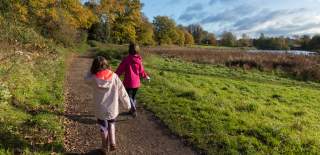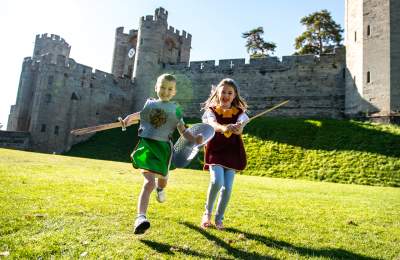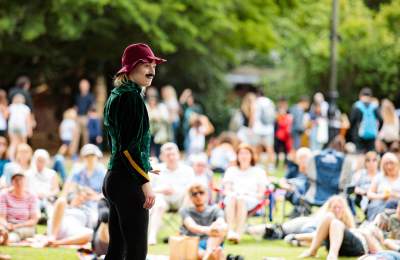Kenilworth Nature Trail
In just a few steps you’ll leave the bustle behind and find yourself swept away in tranquillity, peace and fresh air. Discover the green legacy of our natural heritage, that’s lovingly managed today, just the ticket for a memorable day together. It also offers lots of variety throughout the seasons, so there’s no reason not to stretch your legs!
Abbey Fields
All you can see before you was originally farmland supporting the medieval abbey of St.Mary, which today, 500 years after dissolution is now the glorious green space of Abbey Fields.
The 27 hectares (that’s about 33 football pitches) rolls across both sides of Kenilworth gorge meeting at the low point of the Finham Brook and includes meadows and marsh, managed and wild spaces, and shelters a myriad of species including some 54 varieties of tree.
Visit the Friends of Abbey Fields website or explore the links below for more on Abbey Fields.
Abbey Meadows
On your left as, you descend is an area of rare acid grassland (known locally for toboganning!) which although low in nutrients provides a home for species like the wonderfully named Harebell, Pignut or Catsear!
To your right is an area set aside since 2012 to cultivate a wildflower meadow, carefully managed, this blooms in spring and is harvested for hay in the summer. On reaching the bridge keep an eye out for brown trout swimming in the brook!
Finham Brook & Marsh
Finham Brook is a vital wildlife corridor, its tree-cloaked banks the place to see concentrations of moths on summer evenings and spot birds year round. To the west the brook crosses the road at the Ford (which still floods to this day!)
Beyond the lake is an area of marshland, filled with Bulrushes and alive with White Meadowsweet in late summer and a magical purple haze of Snake-Head Fritillaries in spring. You are also quite likely to spot Herons at the water’s edge.
The Abbey Lake
The lake is the site of the Abbey fish pond, drained in 1650 but restored in the 1990s to alleviate flooding. The lake has its own population of Carp and is a magnet for insects including Dragonflies. Summer evenings see three species of bat arriving to drink (in turn!) and birds flock to the waters year-round including Ducks and Mute Swans.
North of the lake are two mature Oaks, the larger being around 300 years old and the oldest in Abbey Fields.
St. Nicholas Churchyard
The churchyard of St. Nicholas sits upon the ruins of the Abbey and is a wildlife haven even within Abbey Fields. The path is lined with Lime trees and numerous Conifers reside elsewhere in the churchyard. Between the trees it’s a peaceful place to spot Squirrels, insects, wildflowers and if you are lucky hear the calls of Tawny Owls at dusk.
If the wildlife eludes you seek out the church’s unusual wildlife window with its own menagerie!
Parliament Piece
Whilst Henry III did not hold parliament here during the siege of 1266, this 6 hectare oasis of calm grassland is still venerable with hedges thought to be up to 400 years old. Today it is managed by volunteers as a traditional meadow with hay cut in late July and grazed by cattle afterwards.
Butterflies are particularly attracted to the grassland in the summer months, the pond ahead provides a shady shelter for frogs and newts as well as Coots and Moorhens and the tall trees makes this the perfect nesting spot for Kestrels.
Crackley Wood
You are standing in a remnant of the ancient Forest of Arden, which today is a semi-natural wood managed using traditional coppicing. This ensures a wealth of variety of trees and birdlife as well as a network of shady paths and grassy glades – perfect for wildlife spotting! May-time sees a carpet of Bluebells, whilst fungi flourish in the autumn, and throughout the year the brass rubbing trail is a great family diversion!
Kenilworth Greenway
Breaking cover you’ll find yourself on the former Kenilworth to Berkswell railway, which opened in 1884 and carried freight and (allegedly) munitions during the war. The track was closed in the 1960’s and it’s an interesting place to spot wildlife amongst the old railway remnants. Look out for bluebells (in spring) fungi, grass snakes, occasionally Muntjac Deer and keep an eye out for a bat roost in an old railwayman’s hut on your left.
Kenilworth Common
Amazingly this was all grass and heathland back in 1756 when the common was set aside for grazing! However, with grazing banned in the 1800’s the Oaks and Birches have claimed the spot and created 12 hectares of wonderful leafy woodland. Today the common is abundant in birdlife and also particularly rich in fungi in autumn. Take your time and explore and if nothing else seek out the brass-rubbing trail for some extra fun and games!
For a flavour of the past detour under the railway and bear left along the red trail to visit the Little Common, a scarce remnant of the original heathland and a refuge for rare reptiles like the adder and common lizard. Remember to retrace your steps afterwards!
Upper Common
You might have noticed all the lumps and bumps? Well the large depressions were historic gravel quarries, and you are now standing on an ancient trackway that once connected Kenilworth with Coventry. The woodland here is marvellous in its autumn colours, but most impressive in summer when glow-worms flit between the trees after dark.
Finham Brook
Home-stretch now as we follow the leafy path upstream along the brook. The Brook would have been wider here in the past, as it was actually dammed to create wide pools feeding the Mill at the common. Nowadays it’s a babbling stream with resident brown trout and a tranquil spot to catch a glimpse of Kingfishers darting over the water.
Download a PDF of the Kenilworth Nature Trail
Discover more of Shakespeare's England
Things to Do
There's so much to see and do in Shakespeare's England!
Stay
Amazing accommodation to suit all budgets and tastes.
Food & Drink
Find something truly tempting to tuck into.
What's On
Explore a variety of fantastic events.
Follow us on Instagram






